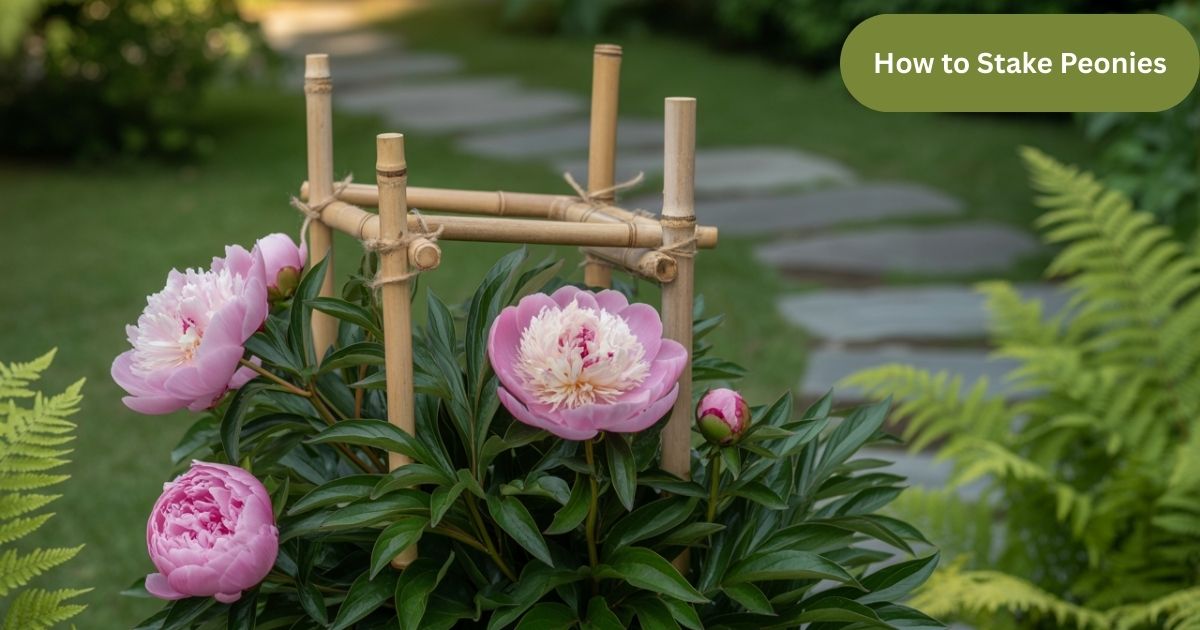Peonies are beautiful but delicate plants that require proper care to thrive. As they grow, their large, heavy blooms can cause the stems to droop or break, especially during windy or rainy weather. Staking helps support these plants, ensuring they remain upright and healthy throughout the season.
Staking peonies not only prevents damage but also encourages optimal growth by allowing the stems to stand tall and reach their full potential. This simple step improves the plant’s appearance, helps maintain proper airflow, and ensures vibrant blooms year after year.
What is Staking and Why is it Important for Peonies?
Staking involves using various materials to provide structural support for plants, preventing them from toppling over. For peonies, staking is vital as their large, heavy flowers can weigh down the stems, especially when the plants are fully bloomed. Without support, peonies may flop over or break under the pressure of their blossoms, which can hinder their growth.
The primary benefit of staking peonies is that it helps the plant grow upright and reach its full potential. When the stems are supported, they can focus on reaching for the sky, rather than struggling to hold the weight of the flowers. This leads to healthier plants, more vibrant flowers, and a better visual impact in your garden.
Best Time to Stake Peonies
The best time to stake peonies is early in their growing season, when the plant is still young. It’s essential to place the stakes before the stems become too thick and the plant begins to bloom. If you wait too long, the flowers and foliage will already be too heavy, making it difficult to position stakes properly without disturbing the plant.
Early staking also helps avoid damaging the peony during the growing process. It allows you to position the support system gently without impacting the roots or existing growth. Ideally, staking should be done when the stems are just a few inches tall, allowing enough time for the plant to grow around the stakes as it matures.
Types of Staking Methods for Peonies
There are several ways to stake peonies, each offering different benefits depending on your garden’s needs. One of the most common methods is using plant cages or hoops, which encircle the plant and provide 360-degree support. These cages are ideal for maintaining a neat shape and preventing peonies from spreading out too much.
Another popular method involves using individual stakes placed at strategic points around the plant. Bamboo or metal stakes can be inserted into the ground and tied to the peony stems as they grow. This approach provides direct support to each stem, allowing for better airflow and light exposure to the plant’s center.
Materials You Can Use to Stake Peonies
When choosing materials for staking peonies, it’s important to consider both functionality and aesthetic. Bamboo stakes are a classic choice because they are lightweight, durable, and blend naturally with the garden. They also provide a discreet way to support your peonies without drawing too much attention away from the plant.
Metal stakes are another excellent option, especially for larger peonies. They are sturdy and long-lasting, providing reliable support for heavy blooms. Alternatively, plastic supports or plant cages are easier to install and maintain, but they may not always provide the same strength as metal or bamboo options.
Step-by-Step Guide to Staking Peonies
To stake peonies, start by selecting the appropriate materials and preparing your support system. For individual stakes, choose a strong material like bamboo or metal, and make sure they are long enough to provide adequate height. Place the stakes in the soil about 2–4 inches from the base of the plant, taking care not to disturb the roots.
Once the stakes are in place, gently tie the peony stems to the supports using soft garden twine or fabric strips. Be careful not to tie them too tightly, as this could restrict their growth. Regularly check the ties to ensure they don’t constrict as the plant grows, allowing it to continue developing freely and without obstruction.
Common Mistakes to Avoid When Staking Peonies
One of the most common mistakes when staking peonies is waiting too long to install the support. If you stake after the peony has grown too tall or started to bloom, it may be challenging to position the stakes properly without causing damage. To avoid this, ensure the stakes are installed early, while the stems are still manageable.
Another mistake is using the wrong materials for staking. Thin or flimsy stakes may bend under the weight of large peony blooms, rendering the staking ineffective. Additionally, tying the stems too tightly to the stakes can restrict their natural growth. Always use soft ties that allow the plant to grow freely without being constricted.
Care Tips for Staked Peonies
Once your peonies are properly staked, it’s important to maintain their care throughout the growing season. Regularly check the stakes to ensure they’re still firmly in place and not causing any damage to the stems. If the plant outgrows its original support, add more stakes or adjust the existing ones to accommodate the new growth.
Also, be mindful of the peony’s health as it grows. Ensure the plant receives adequate sunlight, water, and nutrients to thrive. Removing dead or faded blooms, known as deadheading, can also help improve the appearance of the plant and prevent disease. A well-staked peony is more likely to remain healthy and produce beautiful flowers year after year.
Read More: How to Overwinter Peony Roots
Conclusion
Staking peonies is a simple but essential step in ensuring the health and beauty of these stunning plants. By providing the right support at the right time, you can protect your peonies from damage caused by heavy blooms and adverse weather. Whether you choose plant cages, individual stakes, or other methods, staking will help your peonies grow strong, vibrant, and upright.
With the proper care and maintenance, your staked peonies will thrive and continue to produce breathtaking blooms for many seasons to come. By following these simple steps, you can enjoy the full potential of your peony plants and enhance the overall beauty of your garden.
FAQ’s
When should I stake my peonies?
Stake peonies early in the growing season, before they become too tall or start blooming.
What materials are best for staking peonies?
Bamboo, metal stakes, or plant cages are ideal for supporting peonies.
How do I tie the peony stems to the stakes?
Use soft garden twine or fabric strips to tie the stems gently to avoid restricting growth.
Can I stake peonies after they’ve bloomed?
It’s better to stake them early; staking after blooming may damage the plant.
How often should I check the stakes?
Check regularly to ensure the stakes are secure and the ties aren’t too tight.









